Evaluation of Groundwater Vulnerability of Yishu River Basin Based on DRASTIC-GIS Model
Abstract
1. Introduction
2. Materials and Methods
2.1. Study Area
2.2. Data Collection
2.3. Thematic Layer Preparation
2.4. Evaluation Index Weight Determination
2.5. Calculation of DRASTIC Index
3. Results and Discussion
3.1. Single Evaluation of Vulnerability
3.1.1. Groundwater Depth
3.1.2. Net Recharge of Aquifers
3.1.3. Types of Aquifer Media
3.1.4. Soil Type
3.1.5. Topographic Slope
3.1.6. Medium in the Seepage Area
3.1.7. Hydraulic Conductivity of Aquifer
3.2. Comprehensive Evaluation of Vulnerability
4. Conclusions and Suggestions
Author Contributions
Funding
Data Availability Statement
Conflicts of Interest
References
- Liu, J.; Peng, Y.; Li, C.; Gao, Z.; Chen, S. Characterization of the hydrochemistry of water resources of the Weibei Plain, Northern China, as well as an assessment of the risk of high groundwater nitrate levels to human health. Environ. Pollut. 2021, 268, 115947. [Google Scholar] [CrossRef]
- Ayuba, R.; Tijani, M.N. Hydrochemical characterization of groundwater in Lokoja, North-Central Nigeria. Sustain. Water Resour. Manag. 2021, 7, 61. [Google Scholar] [CrossRef]
- Liu, J.; Wang, M.; Gao, Z.; Chen, Q.; Wu, G.; Li, F. Hydrochemical characteristics and water quality assessment of groundwater in the Yishu River basin. Acta Geophys. 2020, 68, 877–889. [Google Scholar] [CrossRef]
- Liu, J.; Gao, Z.; Wang, M.; Li, Y.; Ma, Y.; Shi, M.; Zhang, H. Study on the dynamic characteristics of groundwater in the valley plain of Lhasa City. Environ. Earth Sci. 2018, 77, 646. [Google Scholar] [CrossRef]
- Mohammadi Arasteh, S.; Shoaei, S.M. Simulation of groundwater resource quantity and quality and assessment of the effects of alluvial material dissolution on the changes of qualitative parameters of the Zanjan Plain, Iran. Arab. J. Geosci. 2023, 16, 60. [Google Scholar] [CrossRef]
- Van Rooyen, J.D.; Watson, A.P.; Miller, J.A. Combining quantity and quality controls to determine groundwater vulnerability to depletion and deterioration throughout South Africa. Environ. Earth Sci. 2020, 79, 255. [Google Scholar] [CrossRef]
- Abdulsalam, A.; Ramli, M.F.; Jamil, N.R.; Ashaari, Z.H.; Umar, D.U.A. Hydrochemical characteristics and identification of groundwater pollution sources in tropical savanna. Environ. Sci. Pollut. Res. 2022, 29, 37384–37398. [Google Scholar] [CrossRef] [PubMed]
- Gugulothu, S.; Subbarao, N.; Das, R.; Dhakate, R. Geochemical evaluation of groundwater and suitability of groundwater quality for irrigation purpose in an agricultural region of South India. Appl. Water Sci. 2022, 12, 142. [Google Scholar] [CrossRef]
- Mukonazwothe, M.; Munyai, L.F.; Mutoti, M.I. Groundwater quality evaluation for domestic and irrigation purposes for the Nwanedi Agricultural Community, Limpopo Province, South Africa. Heliyon 2022, 8, e09203. [Google Scholar] [CrossRef] [PubMed]
- Akbar, H.; Nilsalab, P.; Silalertruksa, T.; Gheewala, S.H. Comprehensive review of groundwater scarcity, stress and sustainability index-based assessment. Groundw. Sustain. Dev. 2022, 18, 100782. [Google Scholar] [CrossRef]
- Dhaouadi, L.; Besser, H.; Karbout, N.; Wassar, F.; Alomrane, A.R. Assessment of natural resources in tunisian Oases: Degradation of irrigation water quality and continued overexploitation of groundwater. Euro-Mediterr. J. Environ. Integr. 2021, 6, 36. [Google Scholar] [CrossRef]
- Li, C.; Gao, Z.; Chen, H.; Wang, J.; Liu, J.; Li, C.; Teng, Y.; Liu, C.; Xu, C. Hydrochemical analysis and quality assessment of groundwater in southeast North China Plain using hydrochemical, entropy-weight water quality index, and GIS techniques. Environ. Earth Sci. 2021, 80, 523. [Google Scholar] [CrossRef]
- Umar, M.; Khan, S.; Arshad, A.; Aslam, R.; Khan, H.; Rashid, H. A modified approach to quantify aquifer vulnerability to pollution towards sustainable groundwater management in irrigated indus basin. Environ. Sci. Pollut. Res. 2022, 29, 27257–27278. [Google Scholar] [CrossRef]
- Zhu, F.; Xiong, L.; Wu, J.; Zhao, Y.; Huang, J.; Wei, J.; Lin, K. Groundwater Vulnerability Assessment in Plain River Network Areas Based on the Improved DRASTIC Model. Environ. Sci. Technol. 2020, 43, 187–193. [Google Scholar]
- Tang, X.; Wu, Y.; Chen, J.; Deng, D. DRASTIC-GIS Model for Assessing Groundwater Vulnerability in Typical Area of Chengdu. Environ. Manag. Monit. Technol. 2020, 32, 28–32. [Google Scholar]
- Zhu, Z.; Wang, J.; Hu, M.; Jia, L. Geographical detection of groundwater pollution vulnerability and hazard in karst areas of Guangxi Province, China. Environ. Pollut. 2019, 245, 627–633. [Google Scholar] [CrossRef] [PubMed]
- Qiu, J. Safeguarding China’s water resources. Natl. Sci. Rev. 2018, 5, 102–107. [Google Scholar] [CrossRef]
- Dizaji, A.R.; Hosseini, S.A.; Rezaverdinejad, V.; Sharafati, A. Groundwater contamination vulnerability assessment using DRASTIC method, GSA, and uncertainty analysis. Arab. J. Geosci. 2020, 13, 645. [Google Scholar] [CrossRef]
- Shakoor, A.; Khan, Z.M.; Farid, H.U.; Sultan, M.; Ahmad, I.; Ahmad, N.; Mahmood, M.H.; Ali, M.U. Delineation of regional groundwater vulnerability using DRASTIC model for agricultural application in Pakistan. Arab. J. Geosci. 2020, 13, 195. [Google Scholar] [CrossRef]
- Rajput, H.; Goyal, R.; Brighu, U. Modification and optimization of DRASTIC model for groundwater vulnerability and contamination risk assessment for Bhiwadi region of Rajasthan, India. Environ. Earth Sci. 2020, 79, 136. [Google Scholar] [CrossRef]
- Asfaw, D.; Mengistu, D. Modeling megech watershed aquifer vulnerability to pollution using modified DRASTIC model for sustainable groundwater management, Northwestern Ethiopia. Groundw. Sustain. Dev. 2020, 11, 100375. [Google Scholar] [CrossRef]
- Janipella, R.; Quamar, R.; Sanam, R.; Jangam, C.; Pandurang Balwant Jyothi, V.; Padmakar, C.; Pujari, P.R. Evaluation of Groundwater Vulnerability to Pollution using GIS Based DRASTIC Method in Koradi, India—A Case Study. J. Geol. Soc. India 2020, 96, 292–297. [Google Scholar] [CrossRef]
- Arya, S.; Subramani, T.; Vennila, G.; Roy, P.D. Groundwater vulnerability to pollution in the semi-arid Vattamalaikarai River Basin of south India thorough DRASTIC index evaluation. Geochemistry 2020, 80, 125635. [Google Scholar] [CrossRef]
- Mali, S.C.; Thabaj, K.A.; Purandara, B.K. Evaluation of Geochemical Characteristics of Groundwater in Parts of Ghataprabha Sub-basin Using DRASTIC Indices. J. Geol. Soc. India 2020, 95, 513–519. [Google Scholar] [CrossRef]
- Rahman, M.; Haque, M.M.; Tareq, S.M. Appraisal of groundwater vulnerability in south-central part of Bangladesh using DRASTIC model: An approach towards groundwater protection and health safety. Environ. Chall. 2021, 5, 100391. [Google Scholar] [CrossRef]
- Shamsuddin, A.S.; Ismail, S.N.S.; Abidin, E.Z.; Bin, H.Y.; Juahir, H.; Bakar, W.A.M.A. Application of GIS-based DRASTIC model approaches in assessing groundwater vulnerability for shallow alluvial aquifer deposited. Arab. J. Geosci. 2021, 14, 2693. [Google Scholar] [CrossRef]
- Antonakos, A.K.; Lambrakis, N.J. Development and testing of three hybrid methods for the assessment of aquifer vulnerability to nitrates, based on the drastic model, an example from ne korinthia, greece. J. Hydrol. 2007, 333, 288–304. [Google Scholar] [CrossRef]
- Goyal, D.; Haritash, A.K.; Singh, S.K. A comprehensive review of groundwater vulnerability assessment using index-based, modelling and coupling methods. J. Environ. Manag. 2021, 296, 113161. [Google Scholar] [CrossRef] [PubMed]
- Moazamnia, M.; Hassanzadeh, Y.; Nadiri, A.A.; Sadeghfam, S. Vulnerability indexing to saltwater intrusion from models at two levels using artificial intelligence multiple model (AIMM). J. Environ. Manag. 2020, 255, 109871.1–109871.11. [Google Scholar] [CrossRef]
- Mojgan, B.; Aminreza, N.; Saman, J. A new hybrid framework for optimization and modification of groundwater vulnerability in coastal aquifer. Environ. Sci. Pollut. Res. 2019, 26, 21808–21827. [Google Scholar]
- Celia, S.F.; Marina, C.B.; Rubén, L.L.; Fátima, S.G. Multiresponse Performance evaluation and life cycle assessment for the optimal elimination of pb (ii) from industrial wastewater by adsorption using vine shoot activated carbon. Sustainability 2023, 15, 11007. [Google Scholar]
- Chakraborty, B.; Roy, S.; Bera, A.; Adhikary, P.P.; Bera, B.; Sengupta, D.; Bhunia, G.S.; Shit, P.K. Groundwater vulnerability assessment using GIS-based DRASTIC model in the upper catchment of Dwarakeshwar river basin, West Bengal, India. Environ. Earth Sci. 2021, 81, 2. [Google Scholar] [CrossRef]
- Koon, A.B.; Anornu, G.K.; Dekongmen, B.W.; Sunkari, E.D.; Agyare, A.; Gyamfi, C. Evaluation of groundwater vulnerability using GIS-based DRASTIC model in Greater Monrovia, Montserrado County, Liberia. Urban Clim. 2023, 48, 101427. [Google Scholar] [CrossRef]
- Patel, P.; Mehta, D.J.; Sharma, N.D. A GIS-based DRASTIC Model for Assessing Groundwater Quality Vulnerability: Case Study of Surat and its Surroundings. J. Geol. Soc. India 2023, 99, 578–582. [Google Scholar] [CrossRef]
- Patel, P.; Mehta, D.; Sharma, N. A review on the application of the DRASTIC method in the assessment of groundwater vulnerability. Water Supply 2022, 22, 5190–5205. [Google Scholar] [CrossRef]
- Patle, D.; Nema, S.; Awasthi, M.K.; Sharma, S.K.; Tiwari, Y.K. Groundwater vulnerability assessment using DRASTIC model in Niwari District of Bundelkhand Region, Madhya Pradesh, India. Arab. J. Geosci. 2022, 15, 1590. [Google Scholar] [CrossRef]
- Smail, R.Q.S.; Dişli, E. Assessment and validation of groundwater vulnerability to nitrate and TDS using based on a modified DRASTIC model: A case study in the Erbil Central Sub-Basin, Iraq. Environ. Monit. Assess. 2023, 195, 567. [Google Scholar] [CrossRef] [PubMed]
- Aller, L.T.; Bennett, T.; Lehr, J.H.; Petty, R.J.; Hackett, G. Drastic: A standardized system for evaluating ground water pollution potential using hidrogeologic settings. J. Geol. Soc. India 1987, 29. [Google Scholar]
- Venkatesan, G.; Pitchaikani, S.; Saravanan, S. Assessment of Groundwater Vulnerability Using GIS and DRASTIC for Upper Palar River Basin, Tamil Nadu. J. Geol. Soc. India 2019, 94, 387–394. [Google Scholar] [CrossRef]
- Aslam, B.; Ismail, S.; Ali, I. A GIS-based DRASTIC model for assessing aquifer susceptibility of Safdarabad Tehsil, Sheikhupura District, Punjab Province, Pakistan. Model. Earth Syst. Environ. 2020, 6, 995–1005. [Google Scholar] [CrossRef]
- Hasan, M.; Islam, M.A.; Aziz Hasan, M.; Alam, M.J.; Peas, M.H. Groundwater vulnerability assessment in Savar upazila of Dhaka district, Bangladesh—A GIS-based DRASTIC modeling. Groundw. Sustain. Dev. 2019, 9, 100220. [Google Scholar] [CrossRef]
- Kaliraj, S.; Chandrasekar, N.; Peter, T.S.; Selvakumar, S.; Magesh, N.S. Mapping of coastal aquifer vulnerable zone in the south west coast of Kanyakumari, South India, using GIS-based DRASTIC model. Environ. Monit. Assess. 2014, 187, 4073. [Google Scholar] [CrossRef] [PubMed]
- Karimzadeh Motlagh, Z.; Derakhshani, R.; Sayadi, M.H. Groundwater vulnerability assessment in central Iran: Integration of GIS-based DRASTIC model and a machine learning approach. Groundw. Sustain. Dev. 2023, 23, 101037. [Google Scholar] [CrossRef]
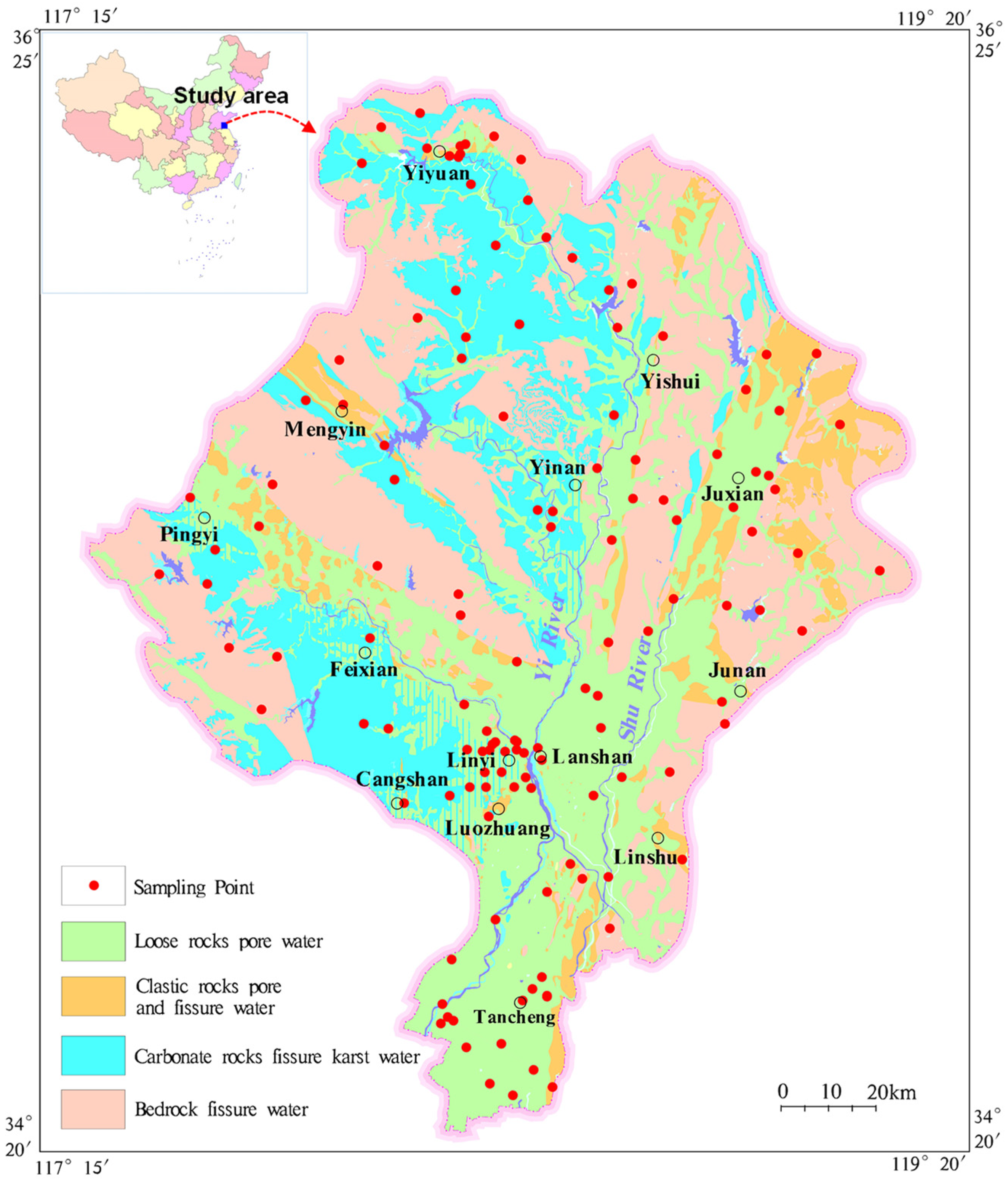

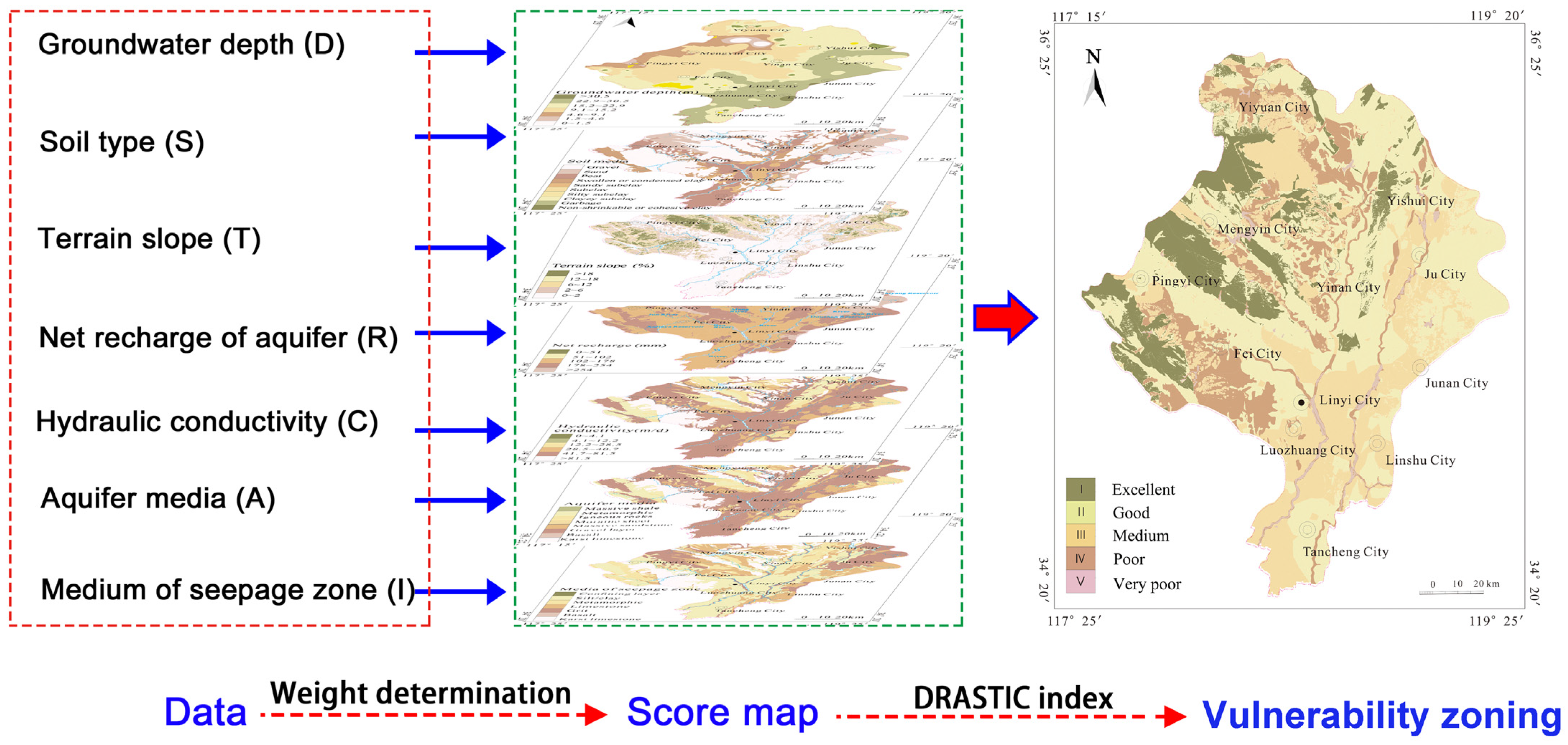




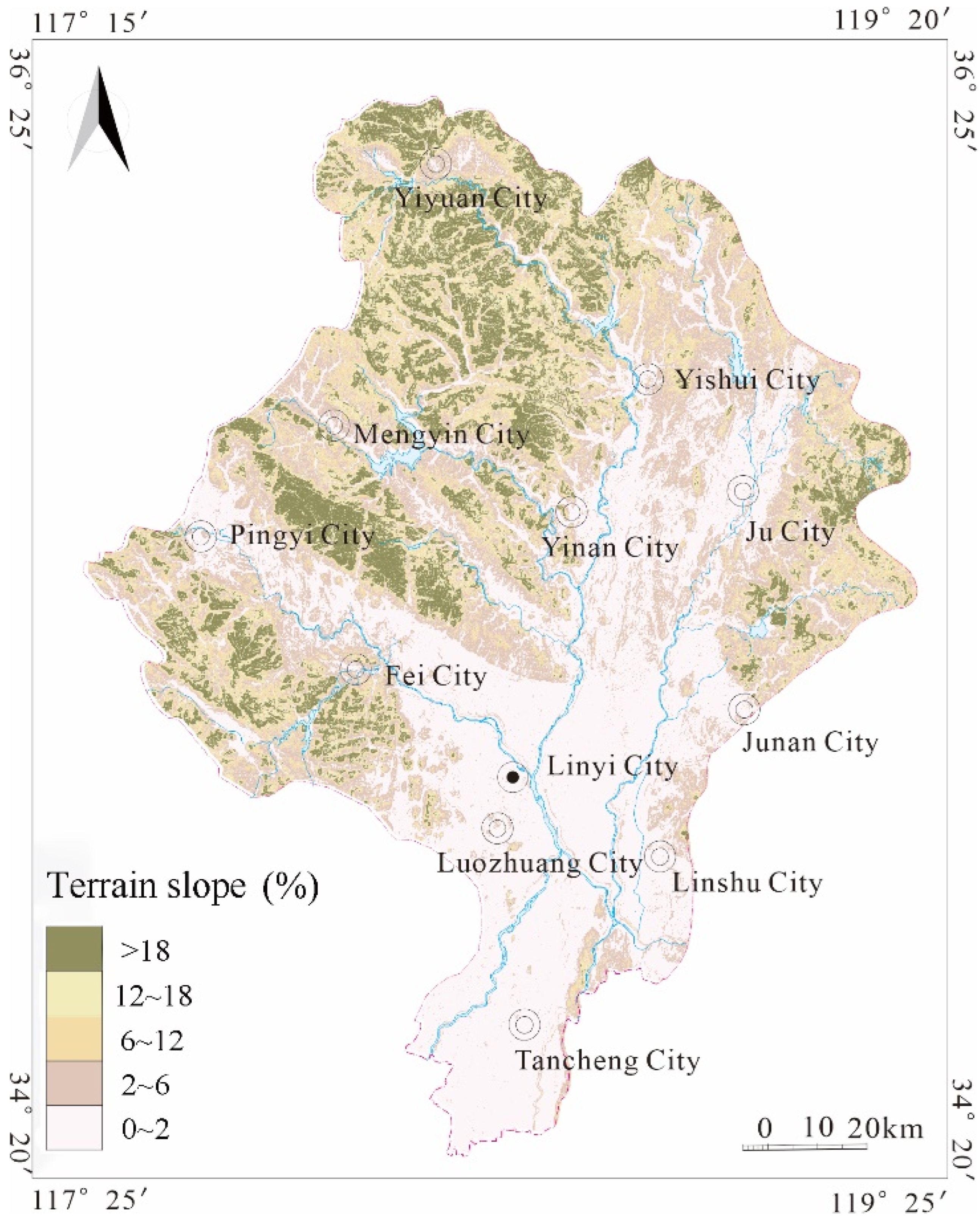

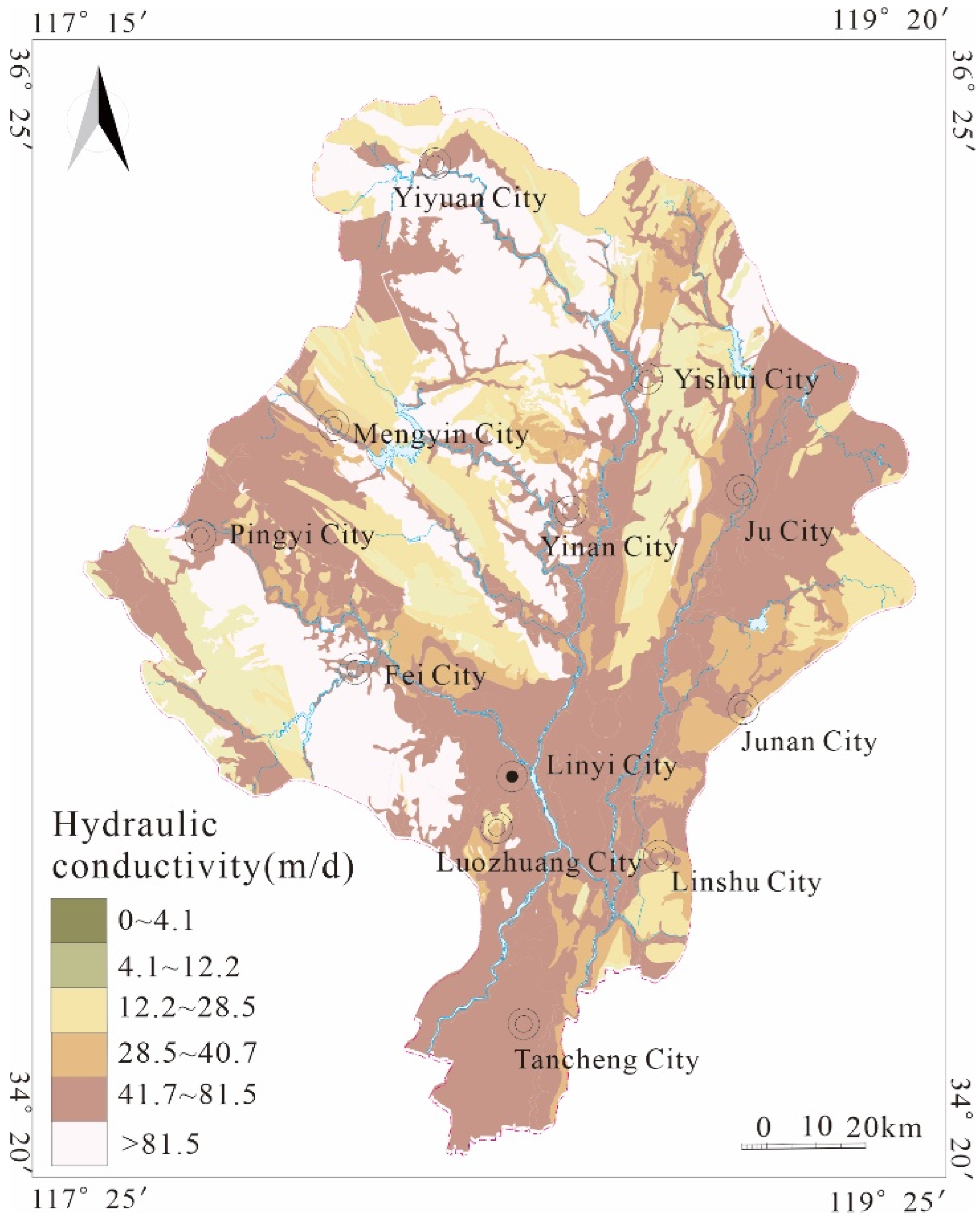
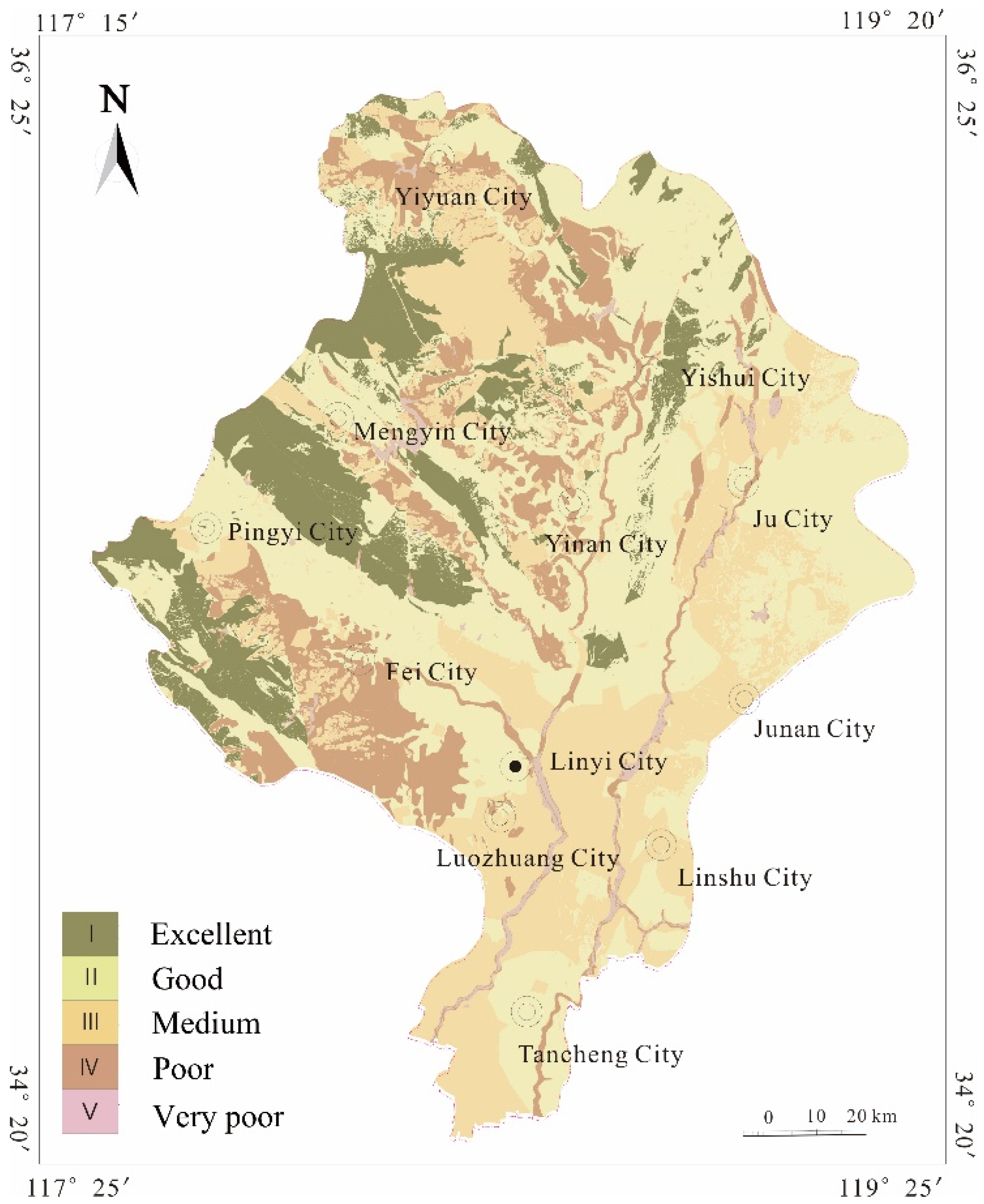
| Groundwater depth (D) | Range (m) | Mark | Hydraulic conductivity (C) | Type (m/d) | Mark |
| 0~1.5 | 10 | 0~4.1 | 1 | ||
| 1.5~4.6 | 9 | 4.1~12.2 | 2 | ||
| 4.6~9.1 | 7 | 12.2~28.5 | 4 | ||
| 9.1~15.2 | 5 | 28.5~40.7 | 6 | ||
| 15.2~22.9 | 3 | 40.7~81.5 | 8 | ||
| 22.9~30.5 | 2 | >81.5 | 10 | ||
| >30.5 | 1 | Aquifer media (A) | Type | Mark | |
| Soil type (S) | Type | Mark | Massive shale | 2 | |
| Thin layer or none | 10 | Metamorphic/igneous rocks | 3 | ||
| Gravel | 10 | Weathered metamorphic/igneous rocks | 4 | ||
| Sand | 9 | Moraine sheet | 5 | ||
| Peat | 8 | Stratified sandstone, limestone, and shale sequences | 6 | ||
| Swollen or condensed clay | 7 | Massive sandstone | 6 | ||
| Sandy subclay | 6 | Massive limestone | 6 | ||
| Subclay | 5 | Gravel layer | 8 | ||
| Silty subclay | 4 | Basalt | 9 | ||
| Clayey subclay | 3 | Karst limestone | 10 | ||
| Garbage | 2 | Medium of seepage zone (I) | Type | Mark | |
| Non-shrinkable or cohesive clay | 1 | Confined layer | 1 | ||
| Terrain slope (T) | Range (%) | Mark | Silt/clay | 3 | |
| 0~2 | 10 | Shale | 3 | ||
| 2~6 | 9 | Limestone | 6 | ||
| 6~12 | 5 | Sandstone | 6 | ||
| 12~18 | 3 | Stratified limestone, sandstone, shale | 6 | ||
| >18 | 1 | Gravel containing more silt and clay | 6 | ||
| Net recharge of aquifer (R) | Type (mm) | Mark | Metamorphic/igneous rocks | 4 | |
| 0~51 | 1 | Grit | 8 | ||
| 51~102 | 3 | Basalt | 9 | ||
| 102~178 | 6 | Karst limestone | 10 | ||
| 178~254 | 8 | ||||
| >254 | 9 |
| Evaluation Index | D | R | A | S | T | I | C |
|---|---|---|---|---|---|---|---|
| Weight | 5 | 4 | 3 | 2 | 1 | 5 | 3 |
| DI | Vulnerability | Rank |
|---|---|---|
| <108 | Excellent | I |
| 108~136 | Good | II |
| 136~164 | Medium | III |
| 164~192 | Poor | IV |
| >192 | Very poor | V |
Disclaimer/Publisher’s Note: The statements, opinions and data contained in all publications are solely those of the individual author(s) and contributor(s) and not of MDPI and/or the editor(s). MDPI and/or the editor(s) disclaim responsibility for any injury to people or property resulting from any ideas, methods, instructions or products referred to in the content. |
© 2024 by the authors. Licensee MDPI, Basel, Switzerland. This article is an open access article distributed under the terms and conditions of the Creative Commons Attribution (CC BY) license (https://creativecommons.org/licenses/by/4.0/).
Share and Cite
Hu, J.; Yang, P.; Li, Q.; Wang, M.; Feng, J.; Gao, Z.; Liu, J. Evaluation of Groundwater Vulnerability of Yishu River Basin Based on DRASTIC-GIS Model. Water 2024, 16, 429. https://doi.org/10.3390/w16030429
Hu J, Yang P, Li Q, Wang M, Feng J, Gao Z, Liu J. Evaluation of Groundwater Vulnerability of Yishu River Basin Based on DRASTIC-GIS Model. Water. 2024; 16(3):429. https://doi.org/10.3390/w16030429
Chicago/Turabian StyleHu, Jiaqi, Peng Yang, Qiang Li, Min Wang, Jianguo Feng, Zongjun Gao, and Jiutan Liu. 2024. "Evaluation of Groundwater Vulnerability of Yishu River Basin Based on DRASTIC-GIS Model" Water 16, no. 3: 429. https://doi.org/10.3390/w16030429
APA StyleHu, J., Yang, P., Li, Q., Wang, M., Feng, J., Gao, Z., & Liu, J. (2024). Evaluation of Groundwater Vulnerability of Yishu River Basin Based on DRASTIC-GIS Model. Water, 16(3), 429. https://doi.org/10.3390/w16030429








